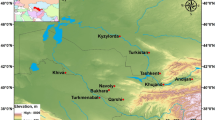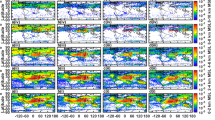Abstract
The Asian dust events in 2008 (May 24–June 4 in 2008) and in 2009 (March 12–25, October 13–26, and December 15–28 in 2009) were analyzed with the lidar network observations, surface observations in China, Korea, Japan, and Mongolia, and with the chemical transport model CFORS. Transport of Asian dust and mixing of dust with air pollution aerosols were studied. The event of May 24 to June 4 in 2008 was a significant event unusually late in the spring dust season. The dust event of March 12–25, 2009 was an interesting example of elevated dust layer, and transport of dust from the elevated dust layer to the ground by the boundary layer activity was observed with the lidars and surface observations in Japan. The concentration of air pollution aerosols was relatively high during the dust event, and the results suggest that vertical structure as well as transport path is important for the mixing of dust and air pollution aerosols. The dust events in October and December 2009 were examples of dust events in autumn and winter. The online mode CFORS reproduced the observation data generally well, except for the event of May 24 to June 4 in 2008. The results of the fourdimensional variational assimilation of the lidar network data reproduced the dust concentration in Korea and Japan reasonably in that event.
Similar content being viewed by others
References
Gillette, D., and R. Passi, 1988: Modeling dust emission caused by wind erosion. J. Geophys. Res., 93, 14, 233–14, 242.
Hara, Y., K. Yumimoto, I. Uno, A. Shimizu, N. Sugimoto, Z. Liu, and D. M. Winker, 2009: Asian dust outflow in the PBL and free atmosphere retrieved by NASA CALIPSO and an assimilated dust transport model. Atmos. Chem. Phys., 9, 1227–1239.
Jugder D., M. Shinoda, N. Sugimoto, I. Matsui, M. Nishikawa, S.-U. Park, Y.-S. Chun, and M.-S. Park, 2011: Spatial and temporal variations of dust concentrations in the Gobi Desert of Mongolia. Global Planet. Change, 78, 14–22.
Kanatani, K. T., I. Ito, W. K. Al-Delaimy, Y. Adachi, W. C. Mathews, J. W. Ramsdell, and Toyama Asian Desert Dust and Asthma Study Team, 2010: Desert-dust exposure is associated with increased risk of asthma hospitalization in children. Am. J. Respir. Crit. Care Med., 182(12) 1475–1481, doi:10.1164/rccm.201002-0296OC.
Kim, S.-W., S.-C. Yoon, J. Kim, J.-Y. Kang, and N. Sugimoto, 2010: Asian dust event observed in Seoul, Korea, during 29–31 May 2008: Analysis of transport and vertical structure of dust particles from lidar and surface measurements. Sci. Total Environ., 408, 1707–1718, doi:10.1016/j.scitotenv.2009.12.018, 2010.
Matsumoto, J., M. Narukawa, K. Takahashi, Y. Matsumi, A. Yabushita, A. Shimizu, I. Matsui, and N. Sugimoto, 2009: Internal mixing of pollutants for submicron particles observed during springtime in Japan. Asian J. of Atmos. Environ., 3-1, 27–41.
Naoe, H., Y. Zaizen, K. Yanagida, H. Takahashi, and Y. Igarashi, 2012: Mixing states of aerosol particles at Mt. Hotaka, Japan: a case study in winter. 92nd American Meteorological Society (AMS) Annual Meeting, New Orleans, U. S. A.
Onishi, K., Y. Kurosaki, S. Otani, A. Yoshida, N. Sugimoto, and Y. Kurozawa, 2012: Atmospheric transport route determines components of Asian dust and health effects in Japan. Atmos. Environ., 49, 94–102, doi:10.1016/j.atmosenv.2011.12.018.
Pereira, S., F. Wagnera, and A. M. Silva. 2008: Scattering properties and mass concentration of local and long-range transported aerosols over the South Western Iberia Peninsula. Atmos. Environ., 42, 7623–7631.
Raut, J.-C., and P. Chazette, 2009: Assessment of vertically-resolved PM10 from mobile lidar observations. Atmos. Chem. Phys., 9, 8617–8638.
Satake, S., and Coauthors, 2004: Characteristics of Asian aerosol transport simulated with a regional-scale chemical transport model during the ACE-Asia observation. J. Geophys. Res., 109, D19S22, doi:10.1029/ 2003JD003997.
Shimizu, A., N. Sugimoto, I. Matsui, K. Arao, I. Uno, T. Murayama, N. Kagawa, K. Aoki, A. Uchiyama, and A. Yamazaki, 2004: Continuous observations of Asian dust and other aerosols by polarization lidar in China and Japan during ACE-Asia. J. Geophys. Res., 109, D19S17, doi:10.1029/2002JD003253.
____, _____, _____, _____, _____, _____, I. Mori, M. Nishikawa and M. Kido, 2011: Relationship between lidar-derived dust extinction coefficients and mass concentrations in Japan. SOLA, 7A, 001–004, doi:10.2151/sola. 7A-001.
____, _____, _____, _____, and _____, _____, 2010: Detailed description of data processing system for lidar network in East Asia. Proc. 25th Int. Laser Radar Conf., St. Petersburg, Russia, 911–913 pp.
Sugimoto, N., I. Uno, M. Nishikawa, A. Shimizu, I. Matsui, X. Dong, Y. Chen, H. Quan, 2003: Record heavy Asian dust in Beijing in 2002: Observations and model analysis of recent events. Geophys. Res. Lett., 30, 1640, doi:10.1029/2002GL016349.
____, _____, and Coauthors, 2008: Lidar network observations of troposheric aerosols. SPIE, 7153, doi: 10.1117/12.806540.
____, _____, Y. Hara, K. Yumimoto, I. Uno, M. Nishikawa, and J. Dulam, 2010: Dust emission estimated with an assimilated dust transport model using lidar network data and vegetation growth in the Gobi desert in Mongolia. SOLA, 6, 125–128, doi:10.2151/sola.2010-032.
____, _____, _____, _____, A. Shimizu, K. Yumimoto, I. Uno, and M. Nishikawa, 2011: Comparison of surface observations and a regional dust transport model assimilated with lidar network data in Asian dust event of March 29 to April 2, 2007. SOLA, 7A, 013–016, doi:10.2151/sola. 7A-004.
Takahashi, H., Y. Igarashi, Y. Inomata, H. Kobayashi, and Y. Zaizen, 2010a: Study of distribution and movement of aerosols using lidar and surface monitoring networks: Aerosol observations on Mt. Haruna and Mt. Shin-Hodaka, The second general meeting of FY 2009 of impacts of aerosols in East Asia on plants and human health, Tsukuba, Japan (in Japanese).
____, _____, H. Naoe, Y. Igarashi, Y. Inomata, and N. Sugimoto, 2010b: Aerosol concentrations observed at Mt. Haruna, Japan, in relation to long-range transport of Asian mineral dust aerosols. Atmos. Environ., 44, 4638–4644, doi:10.1016/j.atmosenv.2010.08.007.
Uematsu, M., A. Yoshikawa, H. Muraki, K. Arao, and I. Uno, 2002: Transport of mineral and anthropogenic aerosols during a Kosa event over East Asia. J. Geophys. Res., 107(D7), 4059, doi:10.1029/ 2001JD000333.
Uno, I., X-M. Cai, D. G. Steyn, and S. Emori, 1995: A simple extension of the louis method for rough surface layer modeling. Bound.-Layer Meteor., 76, 395–409.
____, _____, and Coauthors, 2003: Regional chemical weather forecasting system CFORS: Model descriptions and analysis of surface observations at Japanese island stations during the ACE-Asia experiment. J. Geophys. Res., 108, D23, doi: 10.1029/2002JD002845.
____, _____, and Coauthors, 2004: Numerical study of Asian dust transport during the springtime of 2001 simulated with the Chemical Weather Forecasting System (CFORS) model. J. Geophys. Res., 109, D19S24, doi: 10.1029/2003JD004222.
____, _____, K. Yumimoto, A. Shimizu, Y. Hara, N. Sugimoto, Z. Wang, Z. Liu, and D. M. Winker, 2008: 3D structure of Asian dust transport revealed by CALIPSO and a 4DVAR dust model. Geophys. Res. Lett., 35, L06803, doi: 10.1029/2007GL032329.
Yumimoto, K., I. Uno, N. Sugimoto, A. Shimizu, Z. Liu, and D. M. Winker, 2008: Adjoint inversion modeling of Asian dust emission using lidar observations. Atmos. Chem. Phys., 8, 2869–2884.
Author information
Authors and Affiliations
Corresponding author
Rights and permissions
About this article
Cite this article
Sugimoto, N., Hara, Y., Shimizu, A. et al. Analysis of dust events in 2008 and 2009 using the lidar network, surface observations and the CFORS model. Asia-Pacific J Atmos Sci 49, 27–39 (2013). https://doi.org/10.1007/s13143-013-0004-3
Received:
Revised:
Accepted:
Published:
Issue Date:
DOI: https://doi.org/10.1007/s13143-013-0004-3




